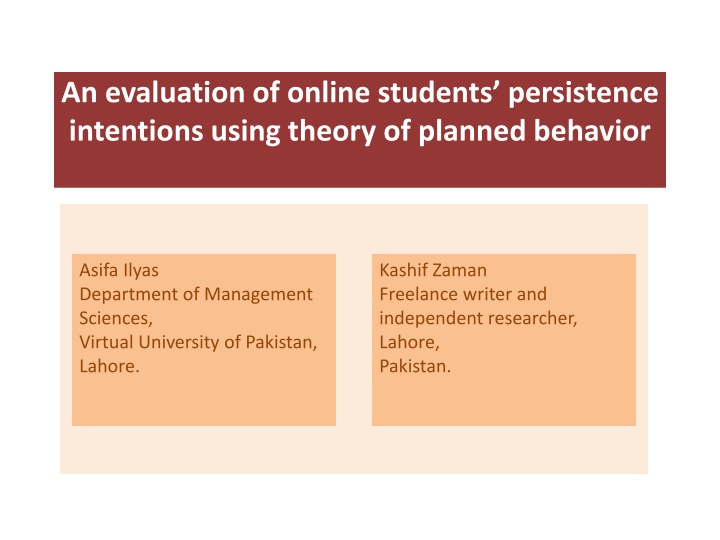
Exploring Online Students' Persistence Intentions Using Theory of Planned Behavior
Discover how the Theory of Planned Behavior is applied to evaluate online students' persistence intentions, addressing dropout rates and predicting student behaviors in virtual education settings. The study focuses on the influence of personal attitudes, subjective norms, and perceived behavioral control on students' persistence decisions.
Download Presentation

Please find below an Image/Link to download the presentation.
The content on the website is provided AS IS for your information and personal use only. It may not be sold, licensed, or shared on other websites without obtaining consent from the author. If you encounter any issues during the download, it is possible that the publisher has removed the file from their server.
You are allowed to download the files provided on this website for personal or commercial use, subject to the condition that they are used lawfully. All files are the property of their respective owners.
The content on the website is provided AS IS for your information and personal use only. It may not be sold, licensed, or shared on other websites without obtaining consent from the author.
E N D
Presentation Transcript
An evaluation of online students persistence intentions using theory of planned behavior Asifa Ilyas Department of Management Sciences, Virtual University of Pakistan, Lahore. Kashif Zaman Freelance writer and independent researcher, Lahore, Pakistan.
Introduction Online education a revolution - Greater flexibility - Unprecedented convenience - Proliferation of online degrees and programs Student dropout a serious issue - Lower rate of completion - Serious concern of policymakers Early identification may help - Identification of potential student dropouts - Reasons for the dropout - Designing of effective interventions
Students dropout Definition The dropout involves a set of diverse and complex factors excluding knowledge which interact to result in students success or failure (Park & Choi, 2009). Previous studies - Data mining techniques - Social and academic integration - No consideration of influence others can exert.
Rationale of the study Theory of planned behavior (TPB) Intentions - Predictor of human behavior - Attitude, subjective norms & perceived behavioral control Application of TPB - - - - - Technology Entrepreneurship Consumer choice Healthcare Environment related issues
Research questions of the study What influence online students closed circle people s opinion exerts on shaping their study persistence decisions? Is it possible to predict persistence of students enrolled in the online study programs?
Variable involved in the study Independent variables - Personal attitude towards behavior - Subjective norms & - Perceived behavioral control Dependent variable - Students persistence intentions
Theoretical model of the study Students persistence intentions Attitude Subjective norms Perceived behavioral control
Research design of the study Population - Students - Convenience sampling Data collection - Questionnaires - Google Docs
Data analysis Correlations - All variables are related to each other - Subjective norms exhibits strongest relation with intentions - Perceived behavioral control shows a weak relation with intentions Regression analysis - Subjective norms with B=.617 is the largest contributor to persistence intentions Personal attitude with B =.247 is the second largest contributor to persistence intentions. Perceived behavioral control accounts for the .213 unit change in the persistence indentions. - -
Important findings of the study Prediction of students persistence Multifaceted phenomenon Antecedents of students persistence decisions Opinion of others matter Closed circle people s opinion exert strongest influence






















